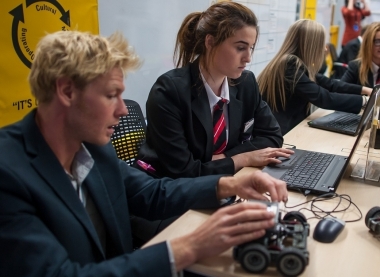Education
Latest
Bringing schools and colleges together – how can we ensure all students know the options open to them?
The Gatsby Benchmarks have provided schools, colleges, universities and employers with a common language for career guidance, but we are still on a journey, and there are some areas where additional effort, particularly around the interactions between secondary schools and colleges, is needed to ensure young people can make the best decisions about their future.

Our latest piece of research into the careers landscape looks at the information provided to students about their onward education options and reveals some concerning, if not surprising trends such as, 11–19-year-olds hear about A-levels on a much more regular basis, and earlier in their school life, than any technical option such as T-levels or apprenticeships. This knowledge gap widens even further when it comes to higher education options, with higher technical qualifications rated as the least well understood of any educational choice.
Since the introduction of the Baker Clause in 2017, schools must provide local colleges and independent training providers (ITPs) access to every student in year 8-13 to discuss future options. But there is little to suggest that this led to an equity of understanding between academic and technical options.
The pattern is reflected in how well schools feel options are described and communicated to their students. Careers Leaders were asked to rate each option on a scale of 1 to 10, with 10 as high confidence that the option was well described. Across the schools surveyed, the average score for A-levels was 9.3, while the score for HNCs and HNDs were 5.4 and 5.5 respectively. This data suggests that, despite the Baker Clause, we are still a long way from parity of knowledge between academic and technical options, both among students and school staff.
Strikingly, this report shows that students are not satisfied with the situation at the moment and want to learn more about technical options. For example, a fifth of respondents were dissatisfied with the information provided about higher technical options, and one in six with information regarding T-levels. One student interviewed from a sixth form college stated: “We’ve never been told anything about apprenticeships. Can you do apprenticeships at university? I didn’t know that.”
So how can school and college leaders address this problem, and get the students the information they need to make their next step?
Colleges and ITPs, as major providers of technical education, are undoubtedly best placed to provide school and students with this information and maintaining good school-college relationships are vital. The schools and colleges surveyed for this work shared useful information on the barriers to successful engagement. Encouragingly, the most cited factors affecting engagement were logistical, with 70% of schools citing pressures on the school timetable, and 57% of colleges noting schools had limited time to arrange sessions. When considering how to tackle this problem, it is important that a school Careers Leader has sufficient backing and investment from their senior leadership team to give them the time to engage with the full range of education options and pass this information on to students.
School Careers Leaders must also be supported to build those important relationships with local colleges and ITPs to ensure that young people (and the wider teaching staff) hear about options early, from year 7, so they are ready to make informed choices at key decision-making points later. There could be a lot to learn from how the path from A-levels direct to undergraduate degrees is explained to students, with regular information from all members of staff and often good partnerships with university outreach programmes.
The report also contains insights into what can make college interactions with schools successful. For example, ‘Outstanding’ colleges not only engage with schools’ careers teams, but also parents of school students as well as SLT and teaching staff. They also tend to gather feedback from both school staff and students following engagements and events.
The range of progression pathways on offer at colleges can be broad – a single FE college may offer T-levels, traineeships, apprenticeship training, and other level 2 and 3 qualifications, as well as a suite of higher education options. The breadth of choice is strikingly different to the narrower offer in most secondary schools. It is unsurprising that some schools and students struggle to understand what’s available, and makes it even more important that colleges are given multiple opportunities to share information with students.
Linked to this, schools reported that they often engage with the colleges which offer clear information about progression from courses. This chimes with what students themselves were most interested in hearing about and indicates that a clear narrative around career and progression opportunities can help colleges achieve more successful engagement with schools.
The problems uncovered by this report are not going to be solved overnight – but they are not insurmountable. They go right to the heart of what education means – preparing young people to embark on their next steps having made the best possible decisions for the future they want – and that is why we will continue to address them.
If you would like to get in contact with Gatsby to share your experience of good school-college relationships, please email careerguidance@gatsby.org.uk

